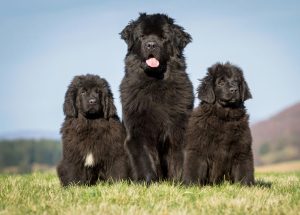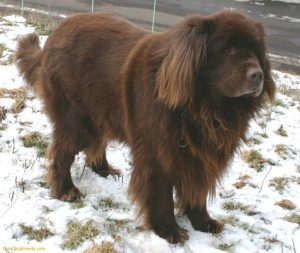Basic information about Newfoundland Dogs
Newfoundland dogs, often referred to simply as Newfoundlands or Newfies, are large and gentle giants known for their calm temperament, intelligence, and strength. Here’s an overview of Newfoundland dogs:
Appearance
Newfoundland dogs are large and muscular with a sturdy build and a distinctive bear-like appearance. They typically stand between 26 to 28 inches (66 to 71 cm) tall at the shoulder for males and slightly less for females. Adult males typically weigh between 130 to 150 pounds (59 to 68 kg), while females weigh slightly less, ranging from 100 to 120 pounds (45 to 54 kg).
They have a thick double coat that provides insulation and protection from harsh weather conditions. The outer coat is coarse and water-resistant, while the undercoat is soft and dense. Newfoundlands come in various colors, including black, brown, gray, and Landseer, which is black with white markings on the chest, feet, and sometimes the face.
Temperament
Newfoundlands are renowned for their gentle and sweet nature. They are known as “gentle giants” due to their calm demeanor and patient disposition.
They are affectionate and devoted family dogs that form strong bonds with their human companions. They are particularly gentle and protective around children, making them excellent family pets.
Despite their large size, Newfoundlands are typically well-behaved and adaptable, making them suitable for various living situations, including apartments, as long as they receive proper exercise and attention.

History
The Newfoundland breed originated in Newfoundland, an island off the east coast of Canada. They were developed by crossing indigenous Canadian dogs with European breeds brought to the island by fishermen and explorers.
Newfoundlands were originally bred as working dogs for fishermen in Newfoundland, where they performed a variety of tasks, including hauling nets, retrieving fishing gear, and rescuing people from the water.
Their natural swimming ability, webbed feet, and water-resistant coat made them well-suited to the maritime environment of Newfoundland. They gained a reputation as excellent water rescue dogs and were utilized by lifesaving organizations worldwide.
Care
Newfoundlands require regular grooming to maintain the health and appearance of their coat. They shed moderately throughout the year and more heavily during seasonal changes, so regular brushing is essential to remove loose hair and prevent matting.
Despite their large size, Newfoundlands have relatively low exercise needs. Daily walks, playtime, and swimming sessions are sufficient to keep them healthy and happy. They enjoy spending time outdoors and excel in activities such as water rescue training, obedience, and agility.
Due to their size, Newfoundlands are prone to certain health issues, including hip dysplasia, elbow dysplasia, and heart conditions. Regular veterinary check-ups, a balanced diet, and maintaining a healthy weight are important for preventing and managing these health concerns.
Temperature

Cold Weather
Newfoundland dogs thrive in cold weather due to their thick, insulating coat, which provides protection against low temperatures and wet conditions.
They have a dense undercoat that traps heat close to their bodies, helping to keep them warm in cold climates.
Despite their cold-weather tolerance, it’s essential to monitor Newfoundland dogs when temperatures drop significantly, especially if they are exposed to freezing temperatures or inclement weather for extended periods. They may still be susceptible to hypothermia or frostbite if not adequately protected.
Hot Weather
Newfoundland dogs are less tolerant of hot weather due to their thick, heavy coat, which can cause them to overheat more easily in warm climates.
They may be prone to heat-related issues, such as heat exhaustion or heatstroke, if exposed to high temperatures or excessive physical activity without adequate cooling and hydration.
It’s crucial to provide Newfoundland dogs with plenty of shade, fresh water, and opportunities to cool down during hot weather. Avoid strenuous exercise during the hottest parts of the day and be vigilant for signs of overheating, such as excessive panting, drooling, lethargy, or collapse.
Regulating Temperature
Newfoundland dogs have several mechanisms for regulating their body temperature, including panting, seeking shade, and resting in cool areas.
Owners can help their Newfoundland dogs stay comfortable in various temperatures by providing a comfortable indoor environment with appropriate heating or cooling systems and access to shade and water when outdoors.
When taking Newfoundland dogs for walks or outdoor activities, it’s essential to be mindful of the temperature and adjust the duration and intensity of exercise accordingly to prevent overheating or discomfort.
Overall, Newfoundland dogs are gentle giants known for their loyalty, intelligence, and versatility. Whether working alongside fishermen or cuddling with their families at home, Newfoundlands make wonderful companions for those seeking a loving and devoted canine companion.
More posts you might be interested in:

